Comparative Analysis of Deceased Organ Donation in UAE and Spain
VerifiedAdded on 2022/08/31
|25
|6507
|12
Report
AI Summary
This report provides a detailed analysis of the deceased organ donation process in the UAE, identifying its current practices, regulations, and challenges. The study employs a literature review and conceptual framework to map the donation procedures, including the roles of transplant coordinators, donor identification, and transplantation regulations. It compares the UAE model with the Spanish organ donation system to highlight gaps and suggest improvements. The research identifies barriers such as lack of funding and poor information integration, which contribute to the inefficient organ donation process in the UAE. The report also explores best practices to enhance the process, aiming to increase the number of potential organ donors and improve transplantation outcomes. The methodology includes secondary data collection from government websites, research articles, and journals, followed by a conceptual framework-based data analysis to accurately depict the phase-wise organ donation and transplantation procedures. The findings underscore the need for systematic improvements to address the limitations and enhance the efficiency of the organ donation system in the UAE.

Running head: DECEASED DONATION PROCESS IN UAE
Mapping the Current Deceased Donation Process in UAE
Name of the Student
Name of the University
Author note
Mapping the Current Deceased Donation Process in UAE
Name of the Student
Name of the University
Author note
Paraphrase This Document
Need a fresh take? Get an instant paraphrase of this document with our AI Paraphraser

2DECEASED DONATION PROCESS IN UAE
Abstract
Organ donation of UAE is facing a procedural deficiency causing very limited number of
potential donors and very limited number of accomplished organ donation activities. The aim
of this study is to critically analyse the current deceased organ donation model including
regulations and practice of UAE while comparing it with the Spanish organ donation model
in order find scope of improvement in UAE. The data collection procedure is based on
secondary data collection through using literature review. For collecting data about organ
transplantation regulations and procedures government websites, previous research articles,
journals, reports of organ donation regulations have been considered. In this study the data
analysis process will be based on conceptual framework design. The conceptual design used
in this research has also a flow of operation to include the phase wise organ donation and
transplantation procedures accurately. From the study it has been found that there are many
factors such as lack of funding and poor information integration within the organ donation
governing authority that contribute to major limitations resulting inefficient organ donation
procedure of UAE and extremely minimum number of potential organ donor.
Abstract
Organ donation of UAE is facing a procedural deficiency causing very limited number of
potential donors and very limited number of accomplished organ donation activities. The aim
of this study is to critically analyse the current deceased organ donation model including
regulations and practice of UAE while comparing it with the Spanish organ donation model
in order find scope of improvement in UAE. The data collection procedure is based on
secondary data collection through using literature review. For collecting data about organ
transplantation regulations and procedures government websites, previous research articles,
journals, reports of organ donation regulations have been considered. In this study the data
analysis process will be based on conceptual framework design. The conceptual design used
in this research has also a flow of operation to include the phase wise organ donation and
transplantation procedures accurately. From the study it has been found that there are many
factors such as lack of funding and poor information integration within the organ donation
governing authority that contribute to major limitations resulting inefficient organ donation
procedure of UAE and extremely minimum number of potential organ donor.
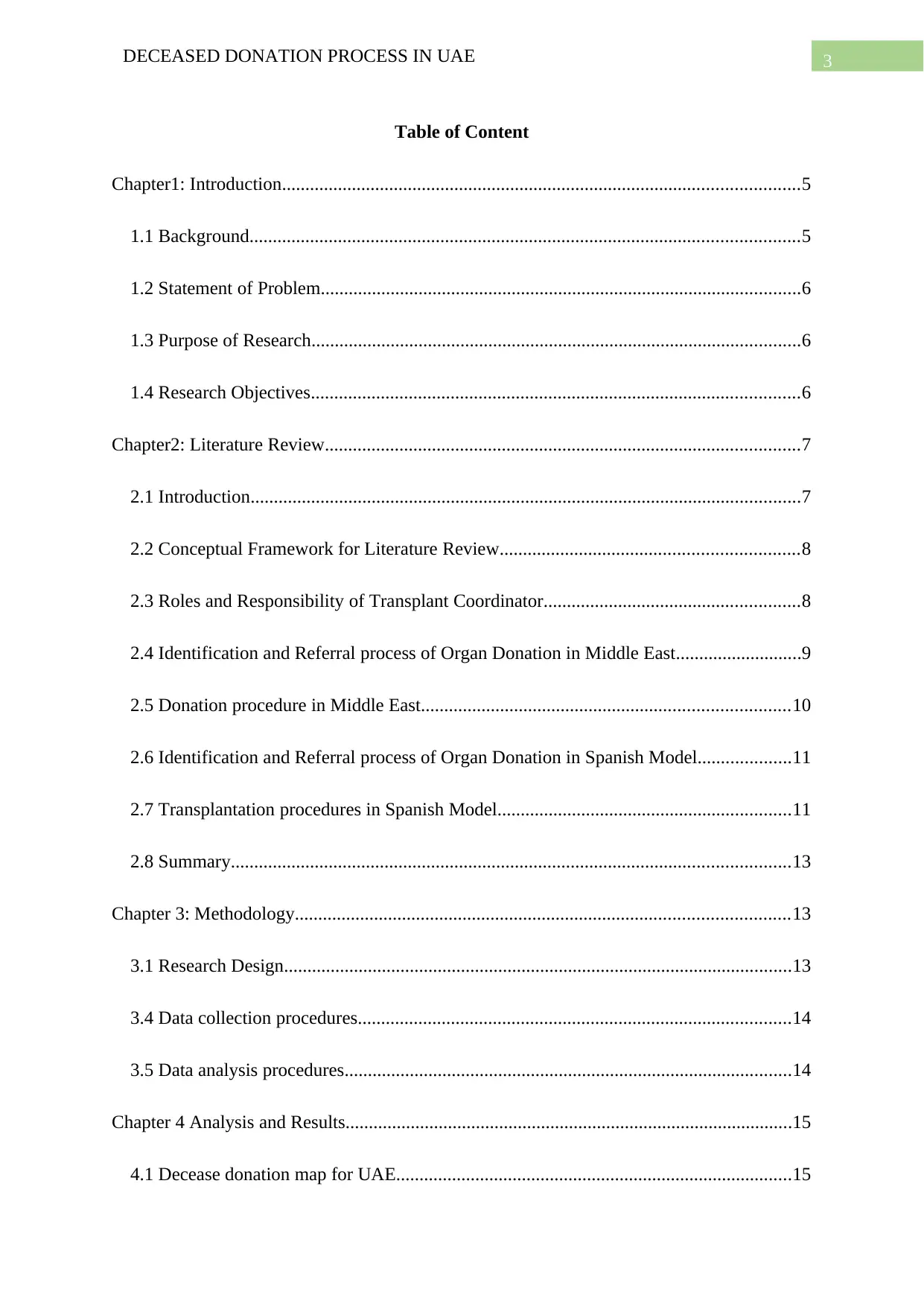
3DECEASED DONATION PROCESS IN UAE
Table of Content
Chapter1: Introduction...............................................................................................................5
1.1 Background......................................................................................................................5
1.2 Statement of Problem.......................................................................................................6
1.3 Purpose of Research.........................................................................................................6
1.4 Research Objectives.........................................................................................................6
Chapter2: Literature Review......................................................................................................7
2.1 Introduction......................................................................................................................7
2.2 Conceptual Framework for Literature Review................................................................8
2.3 Roles and Responsibility of Transplant Coordinator.......................................................8
2.4 Identification and Referral process of Organ Donation in Middle East...........................9
2.5 Donation procedure in Middle East...............................................................................10
2.6 Identification and Referral process of Organ Donation in Spanish Model....................11
2.7 Transplantation procedures in Spanish Model...............................................................11
2.8 Summary........................................................................................................................13
Chapter 3: Methodology..........................................................................................................13
3.1 Research Design.............................................................................................................13
3.4 Data collection procedures.............................................................................................14
3.5 Data analysis procedures................................................................................................14
Chapter 4 Analysis and Results................................................................................................15
4.1 Decease donation map for UAE.....................................................................................15
Table of Content
Chapter1: Introduction...............................................................................................................5
1.1 Background......................................................................................................................5
1.2 Statement of Problem.......................................................................................................6
1.3 Purpose of Research.........................................................................................................6
1.4 Research Objectives.........................................................................................................6
Chapter2: Literature Review......................................................................................................7
2.1 Introduction......................................................................................................................7
2.2 Conceptual Framework for Literature Review................................................................8
2.3 Roles and Responsibility of Transplant Coordinator.......................................................8
2.4 Identification and Referral process of Organ Donation in Middle East...........................9
2.5 Donation procedure in Middle East...............................................................................10
2.6 Identification and Referral process of Organ Donation in Spanish Model....................11
2.7 Transplantation procedures in Spanish Model...............................................................11
2.8 Summary........................................................................................................................13
Chapter 3: Methodology..........................................................................................................13
3.1 Research Design.............................................................................................................13
3.4 Data collection procedures.............................................................................................14
3.5 Data analysis procedures................................................................................................14
Chapter 4 Analysis and Results................................................................................................15
4.1 Decease donation map for UAE.....................................................................................15
⊘ This is a preview!⊘
Do you want full access?
Subscribe today to unlock all pages.

Trusted by 1+ million students worldwide
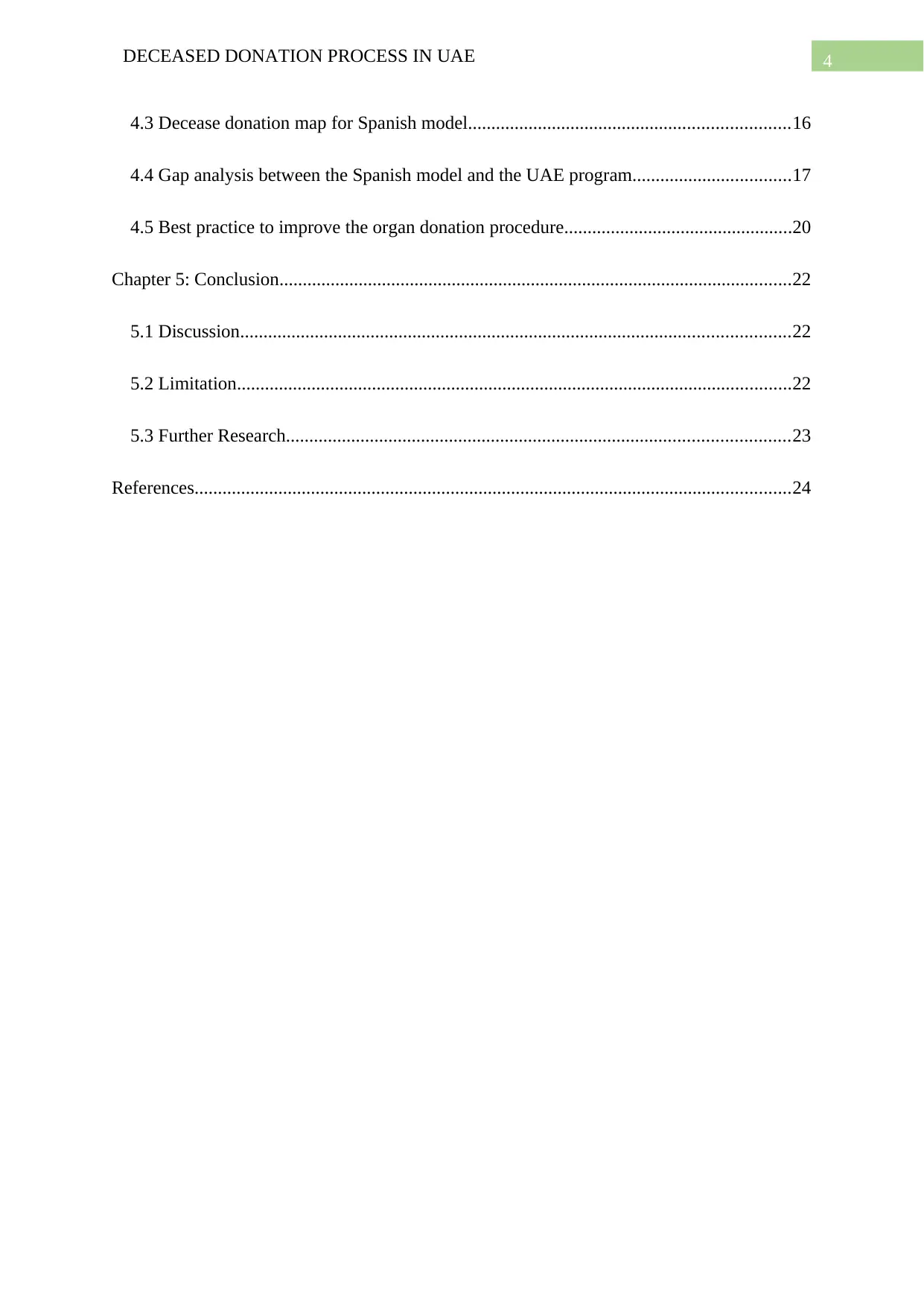
4DECEASED DONATION PROCESS IN UAE
4.3 Decease donation map for Spanish model.....................................................................16
4.4 Gap analysis between the Spanish model and the UAE program..................................17
4.5 Best practice to improve the organ donation procedure.................................................20
Chapter 5: Conclusion..............................................................................................................22
5.1 Discussion......................................................................................................................22
5.2 Limitation.......................................................................................................................22
5.3 Further Research............................................................................................................23
References................................................................................................................................24
4.3 Decease donation map for Spanish model.....................................................................16
4.4 Gap analysis between the Spanish model and the UAE program..................................17
4.5 Best practice to improve the organ donation procedure.................................................20
Chapter 5: Conclusion..............................................................................................................22
5.1 Discussion......................................................................................................................22
5.2 Limitation.......................................................................................................................22
5.3 Further Research............................................................................................................23
References................................................................................................................................24
Paraphrase This Document
Need a fresh take? Get an instant paraphrase of this document with our AI Paraphraser
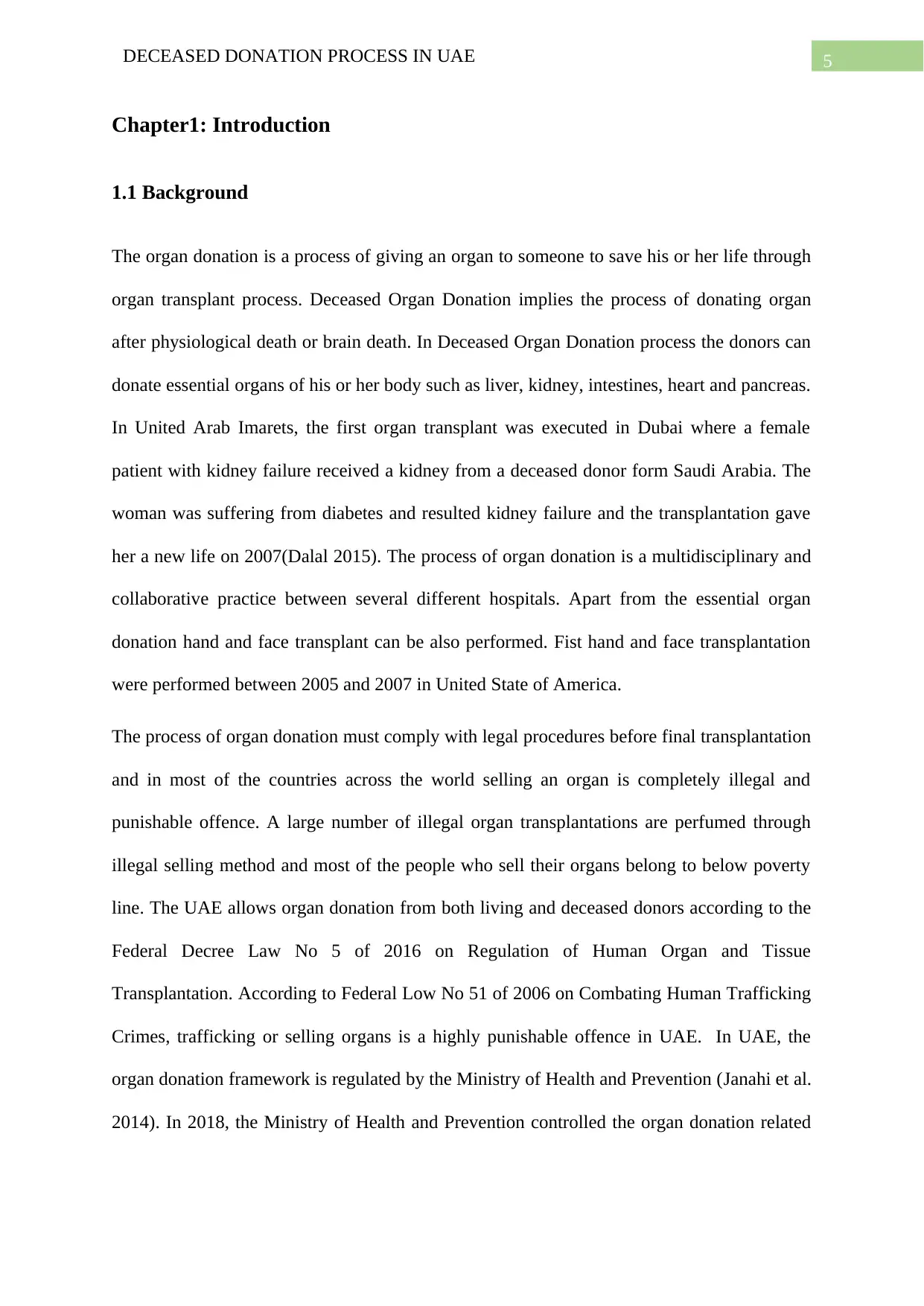
5DECEASED DONATION PROCESS IN UAE
Chapter1: Introduction
1.1 Background
The organ donation is a process of giving an organ to someone to save his or her life through
organ transplant process. Deceased Organ Donation implies the process of donating organ
after physiological death or brain death. In Deceased Organ Donation process the donors can
donate essential organs of his or her body such as liver, kidney, intestines, heart and pancreas.
In United Arab Imarets, the first organ transplant was executed in Dubai where a female
patient with kidney failure received a kidney from a deceased donor form Saudi Arabia. The
woman was suffering from diabetes and resulted kidney failure and the transplantation gave
her a new life on 2007(Dalal 2015). The process of organ donation is a multidisciplinary and
collaborative practice between several different hospitals. Apart from the essential organ
donation hand and face transplant can be also performed. Fist hand and face transplantation
were performed between 2005 and 2007 in United State of America.
The process of organ donation must comply with legal procedures before final transplantation
and in most of the countries across the world selling an organ is completely illegal and
punishable offence. A large number of illegal organ transplantations are perfumed through
illegal selling method and most of the people who sell their organs belong to below poverty
line. The UAE allows organ donation from both living and deceased donors according to the
Federal Decree Law No 5 of 2016 on Regulation of Human Organ and Tissue
Transplantation. According to Federal Low No 51 of 2006 on Combating Human Trafficking
Crimes, trafficking or selling organs is a highly punishable offence in UAE. In UAE, the
organ donation framework is regulated by the Ministry of Health and Prevention (Janahi et al.
2014). In 2018, the Ministry of Health and Prevention controlled the organ donation related
Chapter1: Introduction
1.1 Background
The organ donation is a process of giving an organ to someone to save his or her life through
organ transplant process. Deceased Organ Donation implies the process of donating organ
after physiological death or brain death. In Deceased Organ Donation process the donors can
donate essential organs of his or her body such as liver, kidney, intestines, heart and pancreas.
In United Arab Imarets, the first organ transplant was executed in Dubai where a female
patient with kidney failure received a kidney from a deceased donor form Saudi Arabia. The
woman was suffering from diabetes and resulted kidney failure and the transplantation gave
her a new life on 2007(Dalal 2015). The process of organ donation is a multidisciplinary and
collaborative practice between several different hospitals. Apart from the essential organ
donation hand and face transplant can be also performed. Fist hand and face transplantation
were performed between 2005 and 2007 in United State of America.
The process of organ donation must comply with legal procedures before final transplantation
and in most of the countries across the world selling an organ is completely illegal and
punishable offence. A large number of illegal organ transplantations are perfumed through
illegal selling method and most of the people who sell their organs belong to below poverty
line. The UAE allows organ donation from both living and deceased donors according to the
Federal Decree Law No 5 of 2016 on Regulation of Human Organ and Tissue
Transplantation. According to Federal Low No 51 of 2006 on Combating Human Trafficking
Crimes, trafficking or selling organs is a highly punishable offence in UAE. In UAE, the
organ donation framework is regulated by the Ministry of Health and Prevention (Janahi et al.
2014). In 2018, the Ministry of Health and Prevention controlled the organ donation related
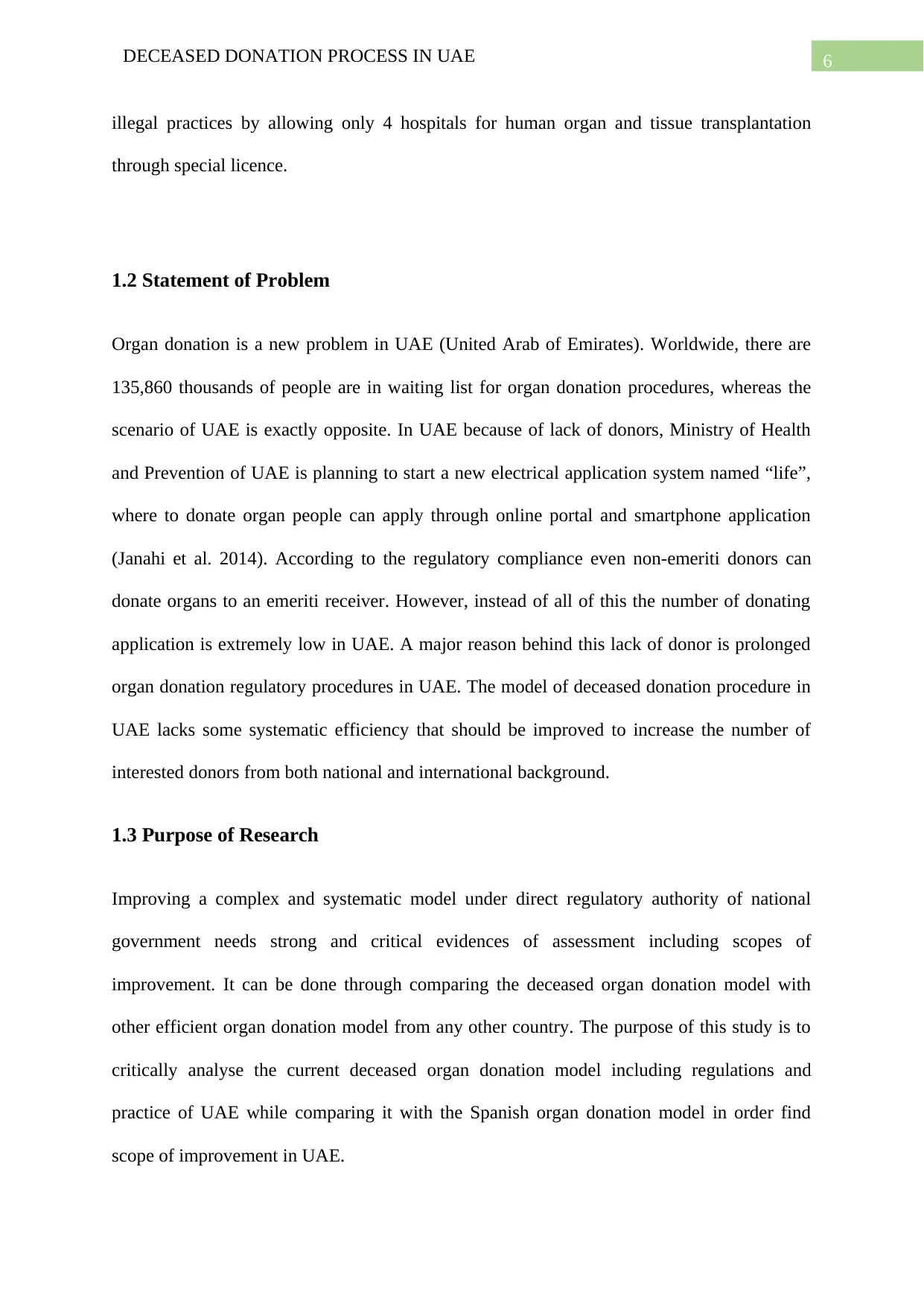
6DECEASED DONATION PROCESS IN UAE
illegal practices by allowing only 4 hospitals for human organ and tissue transplantation
through special licence.
1.2 Statement of Problem
Organ donation is a new problem in UAE (United Arab of Emirates). Worldwide, there are
135,860 thousands of people are in waiting list for organ donation procedures, whereas the
scenario of UAE is exactly opposite. In UAE because of lack of donors, Ministry of Health
and Prevention of UAE is planning to start a new electrical application system named “life”,
where to donate organ people can apply through online portal and smartphone application
(Janahi et al. 2014). According to the regulatory compliance even non-emeriti donors can
donate organs to an emeriti receiver. However, instead of all of this the number of donating
application is extremely low in UAE. A major reason behind this lack of donor is prolonged
organ donation regulatory procedures in UAE. The model of deceased donation procedure in
UAE lacks some systematic efficiency that should be improved to increase the number of
interested donors from both national and international background.
1.3 Purpose of Research
Improving a complex and systematic model under direct regulatory authority of national
government needs strong and critical evidences of assessment including scopes of
improvement. It can be done through comparing the deceased organ donation model with
other efficient organ donation model from any other country. The purpose of this study is to
critically analyse the current deceased organ donation model including regulations and
practice of UAE while comparing it with the Spanish organ donation model in order find
scope of improvement in UAE.
illegal practices by allowing only 4 hospitals for human organ and tissue transplantation
through special licence.
1.2 Statement of Problem
Organ donation is a new problem in UAE (United Arab of Emirates). Worldwide, there are
135,860 thousands of people are in waiting list for organ donation procedures, whereas the
scenario of UAE is exactly opposite. In UAE because of lack of donors, Ministry of Health
and Prevention of UAE is planning to start a new electrical application system named “life”,
where to donate organ people can apply through online portal and smartphone application
(Janahi et al. 2014). According to the regulatory compliance even non-emeriti donors can
donate organs to an emeriti receiver. However, instead of all of this the number of donating
application is extremely low in UAE. A major reason behind this lack of donor is prolonged
organ donation regulatory procedures in UAE. The model of deceased donation procedure in
UAE lacks some systematic efficiency that should be improved to increase the number of
interested donors from both national and international background.
1.3 Purpose of Research
Improving a complex and systematic model under direct regulatory authority of national
government needs strong and critical evidences of assessment including scopes of
improvement. It can be done through comparing the deceased organ donation model with
other efficient organ donation model from any other country. The purpose of this study is to
critically analyse the current deceased organ donation model including regulations and
practice of UAE while comparing it with the Spanish organ donation model in order find
scope of improvement in UAE.
⊘ This is a preview!⊘
Do you want full access?
Subscribe today to unlock all pages.

Trusted by 1+ million students worldwide

7DECEASED DONATION PROCESS IN UAE
1.4 Research Objectives
1. Map the deceased donation practice in UAE including:
a. Potential or eligible Donor identifications
b. The relation between different sectors and the factors that affect the donation
process in UAE
c. Transplant coordinator role throughout the donation process from detection,
evaluation, maintenance, family approach, organ allocation, and retrieval.
2. Identify the barriers in the organ donation process in the UAE.
3. Identify the best evidence-based practice to improve the organ donation process in the
UAE
Chapter2: Literature Review
2.1 Introduction
The purpose of this literature review is to collect secondary data about organ donation
regulatory procedures for both United Arab Emirates and Spain. For the data collection the
government websites, previous research articles, journals, reports of organ donation
regulations have been considered. Literature review can be done through many techniques
such as systematic approach, narrative literature review and thematic literature review. For
the data presentation in this literature review the thematic literature review has been used.
The themes has been chosen by selecting the major attributes of organ donation procedures
that include roles and responsibilities of Transplant Coordinator, identification and referral
process of donor in UAE, transplantation compliances in UAE, identification and referral
1.4 Research Objectives
1. Map the deceased donation practice in UAE including:
a. Potential or eligible Donor identifications
b. The relation between different sectors and the factors that affect the donation
process in UAE
c. Transplant coordinator role throughout the donation process from detection,
evaluation, maintenance, family approach, organ allocation, and retrieval.
2. Identify the barriers in the organ donation process in the UAE.
3. Identify the best evidence-based practice to improve the organ donation process in the
UAE
Chapter2: Literature Review
2.1 Introduction
The purpose of this literature review is to collect secondary data about organ donation
regulatory procedures for both United Arab Emirates and Spain. For the data collection the
government websites, previous research articles, journals, reports of organ donation
regulations have been considered. Literature review can be done through many techniques
such as systematic approach, narrative literature review and thematic literature review. For
the data presentation in this literature review the thematic literature review has been used.
The themes has been chosen by selecting the major attributes of organ donation procedures
that include roles and responsibilities of Transplant Coordinator, identification and referral
process of donor in UAE, transplantation compliances in UAE, identification and referral
Paraphrase This Document
Need a fresh take? Get an instant paraphrase of this document with our AI Paraphraser
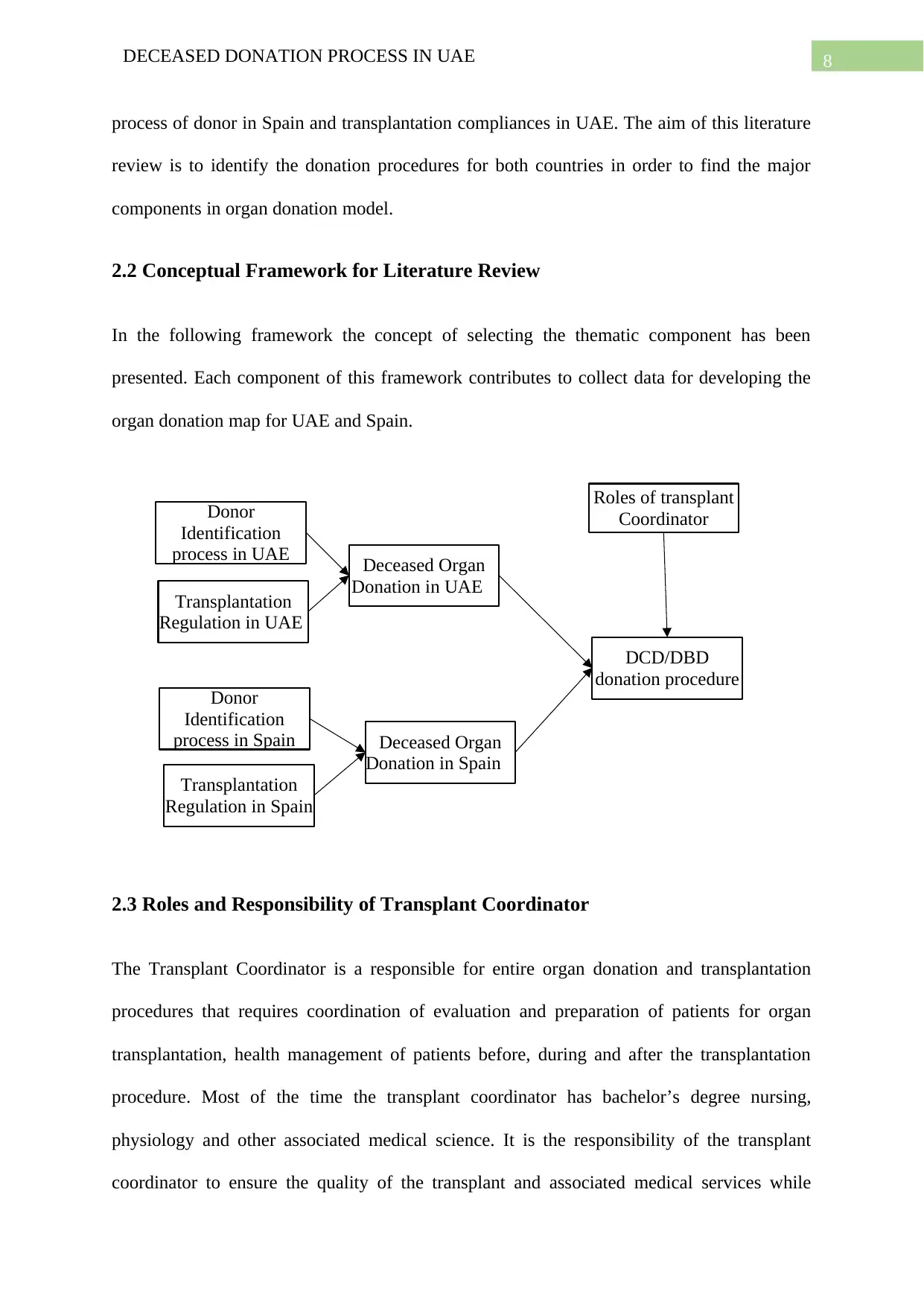
8DECEASED DONATION PROCESS IN UAE
Roles of transplant
CoordinatorDonor
Identification
process in UAE
Transplantation
Regulation in UAE
Deceased Organ
Donation in UAE
Transplantation
Regulation in Spain
Donor
Identification
process in Spain Deceased Organ
Donation in Spain
DCD/DBD
donation procedure
process of donor in Spain and transplantation compliances in UAE. The aim of this literature
review is to identify the donation procedures for both countries in order to find the major
components in organ donation model.
2.2 Conceptual Framework for Literature Review
In the following framework the concept of selecting the thematic component has been
presented. Each component of this framework contributes to collect data for developing the
organ donation map for UAE and Spain.
2.3 Roles and Responsibility of Transplant Coordinator
The Transplant Coordinator is a responsible for entire organ donation and transplantation
procedures that requires coordination of evaluation and preparation of patients for organ
transplantation, health management of patients before, during and after the transplantation
procedure. Most of the time the transplant coordinator has bachelor’s degree nursing,
physiology and other associated medical science. It is the responsibility of the transplant
coordinator to ensure the quality of the transplant and associated medical services while
Roles of transplant
CoordinatorDonor
Identification
process in UAE
Transplantation
Regulation in UAE
Deceased Organ
Donation in UAE
Transplantation
Regulation in Spain
Donor
Identification
process in Spain Deceased Organ
Donation in Spain
DCD/DBD
donation procedure
process of donor in Spain and transplantation compliances in UAE. The aim of this literature
review is to identify the donation procedures for both countries in order to find the major
components in organ donation model.
2.2 Conceptual Framework for Literature Review
In the following framework the concept of selecting the thematic component has been
presented. Each component of this framework contributes to collect data for developing the
organ donation map for UAE and Spain.
2.3 Roles and Responsibility of Transplant Coordinator
The Transplant Coordinator is a responsible for entire organ donation and transplantation
procedures that requires coordination of evaluation and preparation of patients for organ
transplantation, health management of patients before, during and after the transplantation
procedure. Most of the time the transplant coordinator has bachelor’s degree nursing,
physiology and other associated medical science. It is the responsibility of the transplant
coordinator to ensure the quality of the transplant and associated medical services while
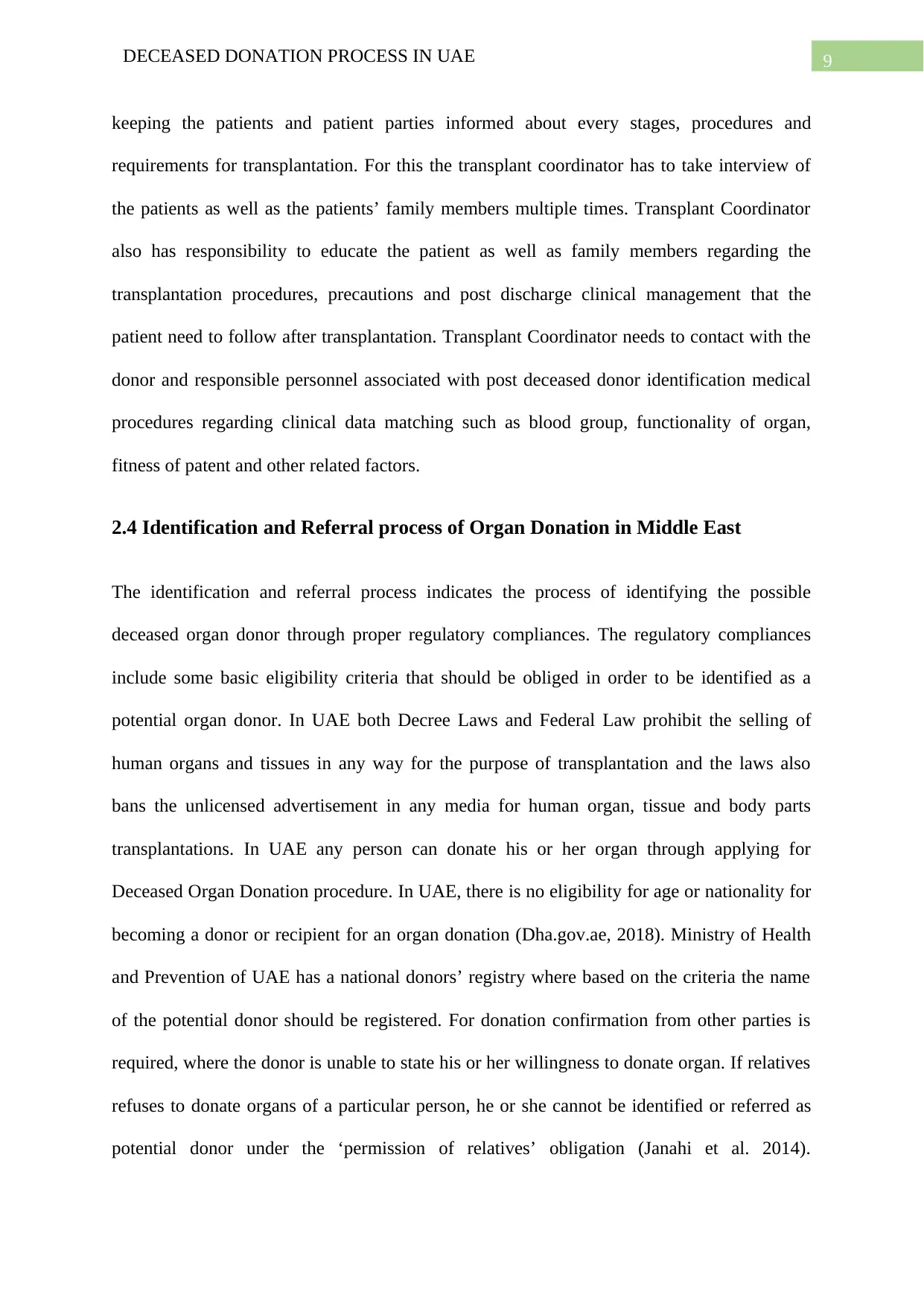
9DECEASED DONATION PROCESS IN UAE
keeping the patients and patient parties informed about every stages, procedures and
requirements for transplantation. For this the transplant coordinator has to take interview of
the patients as well as the patients’ family members multiple times. Transplant Coordinator
also has responsibility to educate the patient as well as family members regarding the
transplantation procedures, precautions and post discharge clinical management that the
patient need to follow after transplantation. Transplant Coordinator needs to contact with the
donor and responsible personnel associated with post deceased donor identification medical
procedures regarding clinical data matching such as blood group, functionality of organ,
fitness of patent and other related factors.
2.4 Identification and Referral process of Organ Donation in Middle East
The identification and referral process indicates the process of identifying the possible
deceased organ donor through proper regulatory compliances. The regulatory compliances
include some basic eligibility criteria that should be obliged in order to be identified as a
potential organ donor. In UAE both Decree Laws and Federal Law prohibit the selling of
human organs and tissues in any way for the purpose of transplantation and the laws also
bans the unlicensed advertisement in any media for human organ, tissue and body parts
transplantations. In UAE any person can donate his or her organ through applying for
Deceased Organ Donation procedure. In UAE, there is no eligibility for age or nationality for
becoming a donor or recipient for an organ donation (Dha.gov.ae, 2018). Ministry of Health
and Prevention of UAE has a national donors’ registry where based on the criteria the name
of the potential donor should be registered. For donation confirmation from other parties is
required, where the donor is unable to state his or her willingness to donate organ. If relatives
refuses to donate organs of a particular person, he or she cannot be identified or referred as
potential donor under the ‘permission of relatives’ obligation (Janahi et al. 2014).
keeping the patients and patient parties informed about every stages, procedures and
requirements for transplantation. For this the transplant coordinator has to take interview of
the patients as well as the patients’ family members multiple times. Transplant Coordinator
also has responsibility to educate the patient as well as family members regarding the
transplantation procedures, precautions and post discharge clinical management that the
patient need to follow after transplantation. Transplant Coordinator needs to contact with the
donor and responsible personnel associated with post deceased donor identification medical
procedures regarding clinical data matching such as blood group, functionality of organ,
fitness of patent and other related factors.
2.4 Identification and Referral process of Organ Donation in Middle East
The identification and referral process indicates the process of identifying the possible
deceased organ donor through proper regulatory compliances. The regulatory compliances
include some basic eligibility criteria that should be obliged in order to be identified as a
potential organ donor. In UAE both Decree Laws and Federal Law prohibit the selling of
human organs and tissues in any way for the purpose of transplantation and the laws also
bans the unlicensed advertisement in any media for human organ, tissue and body parts
transplantations. In UAE any person can donate his or her organ through applying for
Deceased Organ Donation procedure. In UAE, there is no eligibility for age or nationality for
becoming a donor or recipient for an organ donation (Dha.gov.ae, 2018). Ministry of Health
and Prevention of UAE has a national donors’ registry where based on the criteria the name
of the potential donor should be registered. For donation confirmation from other parties is
required, where the donor is unable to state his or her willingness to donate organ. If relatives
refuses to donate organs of a particular person, he or she cannot be identified or referred as
potential donor under the ‘permission of relatives’ obligation (Janahi et al. 2014).
⊘ This is a preview!⊘
Do you want full access?
Subscribe today to unlock all pages.

Trusted by 1+ million students worldwide
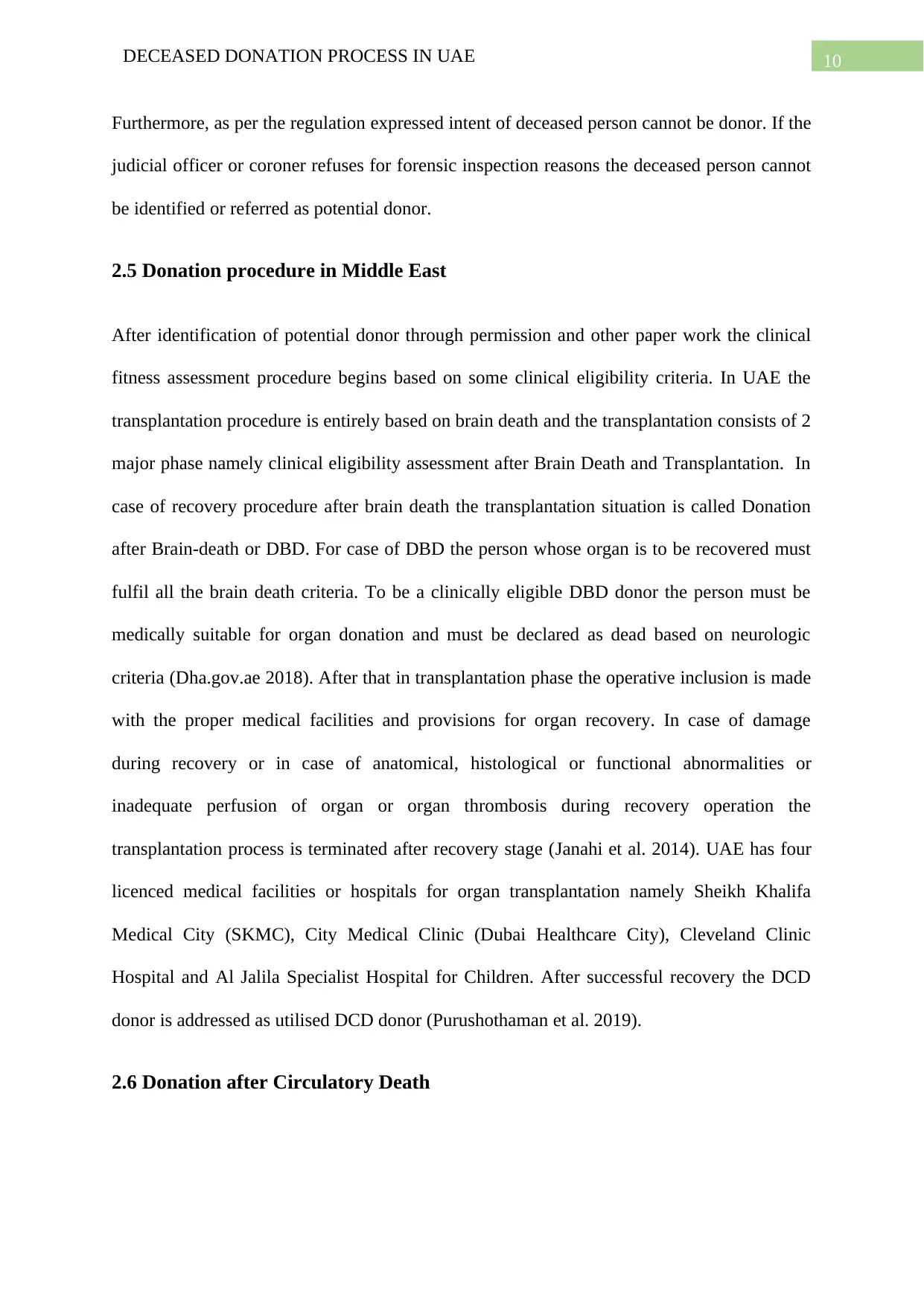
10DECEASED DONATION PROCESS IN UAE
Furthermore, as per the regulation expressed intent of deceased person cannot be donor. If the
judicial officer or coroner refuses for forensic inspection reasons the deceased person cannot
be identified or referred as potential donor.
2.5 Donation procedure in Middle East
After identification of potential donor through permission and other paper work the clinical
fitness assessment procedure begins based on some clinical eligibility criteria. In UAE the
transplantation procedure is entirely based on brain death and the transplantation consists of 2
major phase namely clinical eligibility assessment after Brain Death and Transplantation. In
case of recovery procedure after brain death the transplantation situation is called Donation
after Brain-death or DBD. For case of DBD the person whose organ is to be recovered must
fulfil all the brain death criteria. To be a clinically eligible DBD donor the person must be
medically suitable for organ donation and must be declared as dead based on neurologic
criteria (Dha.gov.ae 2018). After that in transplantation phase the operative inclusion is made
with the proper medical facilities and provisions for organ recovery. In case of damage
during recovery or in case of anatomical, histological or functional abnormalities or
inadequate perfusion of organ or organ thrombosis during recovery operation the
transplantation process is terminated after recovery stage (Janahi et al. 2014). UAE has four
licenced medical facilities or hospitals for organ transplantation namely Sheikh Khalifa
Medical City (SKMC), City Medical Clinic (Dubai Healthcare City), Cleveland Clinic
Hospital and Al Jalila Specialist Hospital for Children. After successful recovery the DCD
donor is addressed as utilised DCD donor (Purushothaman et al. 2019).
2.6 Donation after Circulatory Death
Furthermore, as per the regulation expressed intent of deceased person cannot be donor. If the
judicial officer or coroner refuses for forensic inspection reasons the deceased person cannot
be identified or referred as potential donor.
2.5 Donation procedure in Middle East
After identification of potential donor through permission and other paper work the clinical
fitness assessment procedure begins based on some clinical eligibility criteria. In UAE the
transplantation procedure is entirely based on brain death and the transplantation consists of 2
major phase namely clinical eligibility assessment after Brain Death and Transplantation. In
case of recovery procedure after brain death the transplantation situation is called Donation
after Brain-death or DBD. For case of DBD the person whose organ is to be recovered must
fulfil all the brain death criteria. To be a clinically eligible DBD donor the person must be
medically suitable for organ donation and must be declared as dead based on neurologic
criteria (Dha.gov.ae 2018). After that in transplantation phase the operative inclusion is made
with the proper medical facilities and provisions for organ recovery. In case of damage
during recovery or in case of anatomical, histological or functional abnormalities or
inadequate perfusion of organ or organ thrombosis during recovery operation the
transplantation process is terminated after recovery stage (Janahi et al. 2014). UAE has four
licenced medical facilities or hospitals for organ transplantation namely Sheikh Khalifa
Medical City (SKMC), City Medical Clinic (Dubai Healthcare City), Cleveland Clinic
Hospital and Al Jalila Specialist Hospital for Children. After successful recovery the DCD
donor is addressed as utilised DCD donor (Purushothaman et al. 2019).
2.6 Donation after Circulatory Death
Paraphrase This Document
Need a fresh take? Get an instant paraphrase of this document with our AI Paraphraser
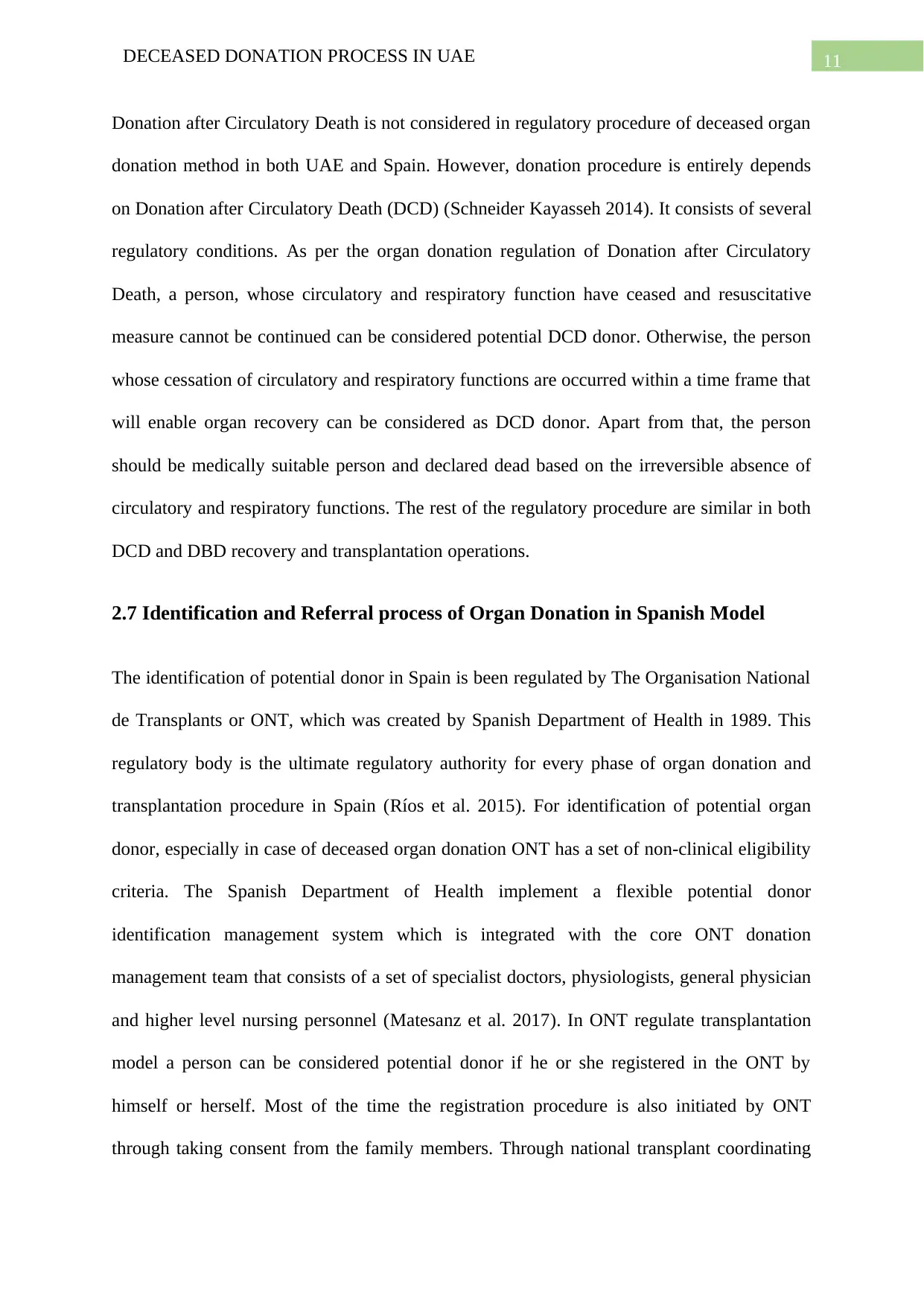
11DECEASED DONATION PROCESS IN UAE
Donation after Circulatory Death is not considered in regulatory procedure of deceased organ
donation method in both UAE and Spain. However, donation procedure is entirely depends
on Donation after Circulatory Death (DCD) (Schneider Kayasseh 2014). It consists of several
regulatory conditions. As per the organ donation regulation of Donation after Circulatory
Death, a person, whose circulatory and respiratory function have ceased and resuscitative
measure cannot be continued can be considered potential DCD donor. Otherwise, the person
whose cessation of circulatory and respiratory functions are occurred within a time frame that
will enable organ recovery can be considered as DCD donor. Apart from that, the person
should be medically suitable person and declared dead based on the irreversible absence of
circulatory and respiratory functions. The rest of the regulatory procedure are similar in both
DCD and DBD recovery and transplantation operations.
2.7 Identification and Referral process of Organ Donation in Spanish Model
The identification of potential donor in Spain is been regulated by The Organisation National
de Transplants or ONT, which was created by Spanish Department of Health in 1989. This
regulatory body is the ultimate regulatory authority for every phase of organ donation and
transplantation procedure in Spain (Ríos et al. 2015). For identification of potential organ
donor, especially in case of deceased organ donation ONT has a set of non-clinical eligibility
criteria. The Spanish Department of Health implement a flexible potential donor
identification management system which is integrated with the core ONT donation
management team that consists of a set of specialist doctors, physiologists, general physician
and higher level nursing personnel (Matesanz et al. 2017). In ONT regulate transplantation
model a person can be considered potential donor if he or she registered in the ONT by
himself or herself. Most of the time the registration procedure is also initiated by ONT
through taking consent from the family members. Through national transplant coordinating
Donation after Circulatory Death is not considered in regulatory procedure of deceased organ
donation method in both UAE and Spain. However, donation procedure is entirely depends
on Donation after Circulatory Death (DCD) (Schneider Kayasseh 2014). It consists of several
regulatory conditions. As per the organ donation regulation of Donation after Circulatory
Death, a person, whose circulatory and respiratory function have ceased and resuscitative
measure cannot be continued can be considered potential DCD donor. Otherwise, the person
whose cessation of circulatory and respiratory functions are occurred within a time frame that
will enable organ recovery can be considered as DCD donor. Apart from that, the person
should be medically suitable person and declared dead based on the irreversible absence of
circulatory and respiratory functions. The rest of the regulatory procedure are similar in both
DCD and DBD recovery and transplantation operations.
2.7 Identification and Referral process of Organ Donation in Spanish Model
The identification of potential donor in Spain is been regulated by The Organisation National
de Transplants or ONT, which was created by Spanish Department of Health in 1989. This
regulatory body is the ultimate regulatory authority for every phase of organ donation and
transplantation procedure in Spain (Ríos et al. 2015). For identification of potential organ
donor, especially in case of deceased organ donation ONT has a set of non-clinical eligibility
criteria. The Spanish Department of Health implement a flexible potential donor
identification management system which is integrated with the core ONT donation
management team that consists of a set of specialist doctors, physiologists, general physician
and higher level nursing personnel (Matesanz et al. 2017). In ONT regulate transplantation
model a person can be considered potential donor if he or she registered in the ONT by
himself or herself. Most of the time the registration procedure is also initiated by ONT
through taking consent from the family members. Through national transplant coordinating

12DECEASED DONATION PROCESS IN UAE
network the data has been managed for potential donors for further evaluation of eligibility.
In Spanish the organ donation cycle starts from two way model, where at one point the
patient’s medical data who is potential receiver is stored and managed and at another point
the data of potential donors has been gathered and evaluated (Febrero et al. 2014). After
registering into ONT potential donor list the data of the specific donors managed in organ
sharing and management waiting list on which the statistical calculation and analysis method
is conducted for aligning the available donor with potential receivers.
2.8 Transplantation procedures in Spanish Model
The organ transplantation process in Spain is integrated with Organ Transplantation
Management Team under the regulatory control of ONT. The transplantation process is a two
way process where the data of potential donors and potential receivers are managed on organ
transplantation database. According to the regulatory compliance controlled by The
Organisation National de Transplants or ONT, the base clinical criteria for potential donor is
that he person should be medically suitable person and declared as brain death based on the
neurologic condition assessment report. If a person’s circulatory
and respiratory functions are stable and the person’s neurologic condition satisfies
neurologic criteria as stipulated by the law of the relevant jurisdiction, the organ recovery
procedure can be initiated (Ríos et al. 215). In organ recovery phase the operative inclusion is
made with the proper medical facilities and provisions for organ recovery. However, in case
of serology positive, neoplasia, Haemodynamic instability the recovery procedure is
postponed. Apart from that anatomical, histological, functional abnormalities in target organ
can also terminate the organ recovery procedure. During recovery operation if inadequate
perfusion, thrombosis are occurred the recovery process is terminated. On the other, after a
successful recovery of organ from donor’s body the organ is stored under the medical
network the data has been managed for potential donors for further evaluation of eligibility.
In Spanish the organ donation cycle starts from two way model, where at one point the
patient’s medical data who is potential receiver is stored and managed and at another point
the data of potential donors has been gathered and evaluated (Febrero et al. 2014). After
registering into ONT potential donor list the data of the specific donors managed in organ
sharing and management waiting list on which the statistical calculation and analysis method
is conducted for aligning the available donor with potential receivers.
2.8 Transplantation procedures in Spanish Model
The organ transplantation process in Spain is integrated with Organ Transplantation
Management Team under the regulatory control of ONT. The transplantation process is a two
way process where the data of potential donors and potential receivers are managed on organ
transplantation database. According to the regulatory compliance controlled by The
Organisation National de Transplants or ONT, the base clinical criteria for potential donor is
that he person should be medically suitable person and declared as brain death based on the
neurologic condition assessment report. If a person’s circulatory
and respiratory functions are stable and the person’s neurologic condition satisfies
neurologic criteria as stipulated by the law of the relevant jurisdiction, the organ recovery
procedure can be initiated (Ríos et al. 215). In organ recovery phase the operative inclusion is
made with the proper medical facilities and provisions for organ recovery. However, in case
of serology positive, neoplasia, Haemodynamic instability the recovery procedure is
postponed. Apart from that anatomical, histological, functional abnormalities in target organ
can also terminate the organ recovery procedure. During recovery operation if inadequate
perfusion, thrombosis are occurred the recovery process is terminated. On the other, after a
successful recovery of organ from donor’s body the organ is stored under the medical
⊘ This is a preview!⊘
Do you want full access?
Subscribe today to unlock all pages.

Trusted by 1+ million students worldwide
1 out of 25
Your All-in-One AI-Powered Toolkit for Academic Success.
+13062052269
info@desklib.com
Available 24*7 on WhatsApp / Email
![[object Object]](/_next/static/media/star-bottom.7253800d.svg)
Unlock your academic potential
Copyright © 2020–2025 A2Z Services. All Rights Reserved. Developed and managed by ZUCOL.
